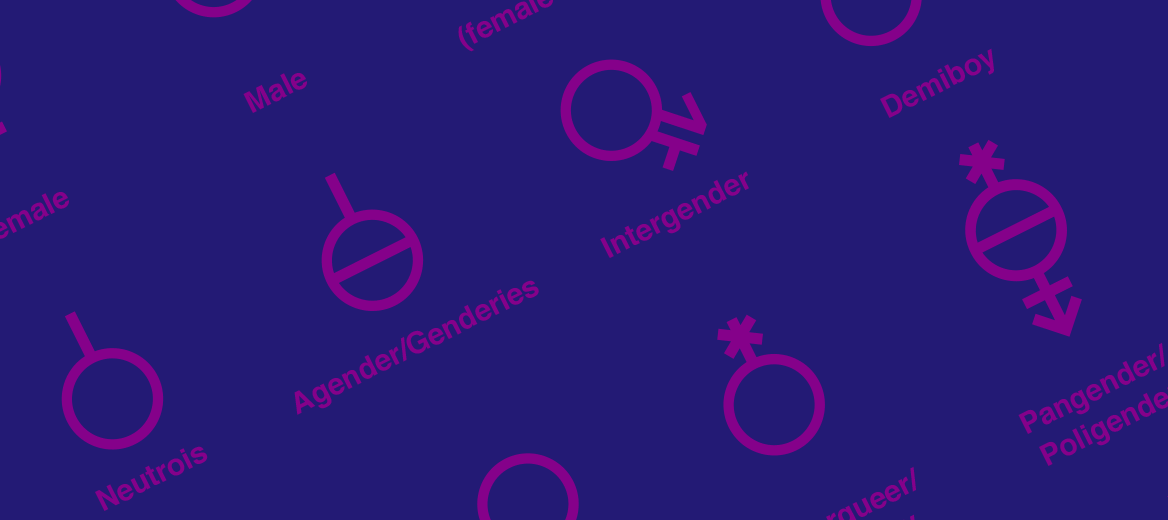HEALTH + WELLNESS
Understanding & Respecting Gender Identities

Gender identity and expression can be a complex - and ever evolving - process when you're figuring out who you are and how you show up in the world. But the basic rule for respecting gender identity is simple: people are who they say they are, and you take them at their (or his/her/zir) word.
Important note: The information here cannot capture the range of gender identities and experiences - nor can any single article. Learning about gender identity and expression, sexual orientation, relationships and being a good partner is a lifelong journey. So consider this a starting point, and keep learning more, especially from others.
In this article:
Talking about Your Own Gender Identity or Sexuality and Accepting Others
Gender Identity vs. Biological Sex: What's the Difference?
What is the Gender Binary and the Gender Spectrum?
What Does Cisgender and Transgender Mean?
What are some Examples of Gender Identities?
How do Pronouns Fit into Gender Identities?
Respecting others and their Gender Identities, No Matter What They Are
Talking about Your Own Gender Identity or Sexuality and Accepting Others
When you're thinking about yourself, your body, and who you might be attracted to romantically or sexually, you'll have to decide who you are and what you like. This is a process and often takes experimentation! You're not born knowing everything about yourself, and you may not know if you like something until you try it. That's super okay, and totally normal.
One of the "who you are" parts you'll need to figure out is your gender vs. biological sex. These are ways of describing yourself, along with how tall you are, your hair color, and what you like to do. Your gender may be "cis" or "trans" and there are many gender identities, including male, female, nonbinary, and others. We'll explain more below.
Figuring out "who you are attracted to" is your sexual orientation. You might be heterosexual, also known as "straight," meaning you are sexually attracted to people who are of another sex or gender than yourself (hetero means different). There are many other sexual orientations, such as being attracted to someone who is the same gender or sex as you, attracted to all genders, or attracted to some but not others. There are also people who do not experience sexual attraction at all, or only rarely. To learn more about sexual orientation, check out our basic guide to sexuality.
But back to gender and biological sex. There are three main things to remember about defining sex and gender:
1. Biological sex and gender identity are not the same. Genitals do not determine gender.
2. Each person has the right and freedom to define themselves, including their gender identity and expression.
3. All gender identities are valid, yours and anyone else's. You be you, and let others be themselves.
Gender Identity vs. Biological Sex: What's the Difference?
While biological sex and gender are two terms that help describe a person, they are not the same. In general, biological sex refers to characteristics of a person's body, such as chromosomes and reproductive organs, while gender refers to how a person sees themselves and interacts in the world.
What is Biological Sex?
A person's sex refers to the label of male or female that is assigned at birth. The labels "male" and "female" are part of a classification system Western scientists use to divide individuals of various species into two categories based on physical differences such as hair, horns, color or reproductive organs.
Using this sex classification system, all human babies are assigned either male or female at birth, depending on whether a penis and scrotum or a vulva and vagina are observed.
However, a glance from a doctor at birth doesn't always reveal the whole of biological sex. Between 1 and 2 percent of babies (about the same percentage of people who have red hair) are intersex, or born with a mixture of what are considered male or female sex characteristics.
So while biological sex may seem a clear-cut distinction neatly dividing humans into the binary of male and female, it often is not. The two options of male or female don't cover all possibilities of human beings.
What is Gender Identity?
Gender is an even more complex concept than biological sex. A person's gender does not correspond to a certain body or genitals. Gender is a social (and legal) status that determines how the world will see you, define you and treat you. It's also a fundamental part of who you are and how you interact with others.
Gender is made of two main aspects: how a person feels about themselves (their gender identity) and how a person presents to others (gender expression). Each society has expectations, standards and norms for what it considers a specific gender (woman or man) to be. How you relate to those expectations helps create your gender identity and how you perform those expectations (by meeting them or rebelling against them) is part of your gender expression.
Gender Identity is about how you see yourself as a person. It might be as a boy/man, a girl/woman, as neither, or as a combination.
Gender Expression refers to how you show up in the world. It includes how you walk and talk, what you wear, how you look, how you act. It also includes how you want others to see you since they make deductions about who you are based on whether you conform to society's standards of masculine or feminine.
Important: a person's gender is personal and should be respected. Don't make value judgments about how any gender is "better" or "worse" or "smarter" or "more aggressive" than another gender. That reduces people to stereotypes. Also, don't make the mistake of questioning someone's gender identity. Remember, people are who they say they are -- including if you don't think they look like a certain gender or agree with their expression.
What is the Gender Binary and the Gender Spectrum?
The gender binary and the gender spectrum are two ways of thinking about gender. Not every society has the same definitions of gender or what it means to be a specific gender.
What is the Gender Binary?
The gender binary is a method of explaining gender in Western countries that only recognizes two genders: male and female. People are considered one or the other gender, male and female are considered opposites, and there are no other options. People may use the terms gender and sex interchangeably.
What is the Gender Spectrum
The gender spectrum recognizes many genders including male and female and others that exist anywhere between or outside of those genders. A gender spectrum system is more common in non-Western societies. Many cultures around the world have acknowledged more than two genders for thousands of years.
The way you think about gender - your own or someone else's - isn't universal and can't be forced on other people from different cultures or with different ideas. You get to decide who you are, and no one else. Period.
Gender Nonconforming and Nonbinary Gender
A binary definition of gender is more restrictive than the gender spectrum. With only two options of male and female, many people don't feel they fit into one or the other. There are so many questions that a gender binary cannot answer, such as:
What if you feel somewhat like a man and somewhat like a woman?
What if you identify as a woman, but don't look or act in ways that society thinks are proper for women?
What if you are a man who prefers to do or wear things that society says are for women?
What if other people think you are a man but you don't think of yourself that way?
What if you feel more masculine today but more feminine tomorrow or next week?
What if you want to be a human being and not defined as either a man or a woman?
People who have asked any of these questions or don't see themselves as strictly male or female are gender nonconforming, meaning they do not follow conventional Western definitions of male or female. Their gender may be nonbinary, meaning beyond the binary classification of either male or female. People with a nonbinary gender identity may think of themselves as neither male nor female, somewhere along a spectrum between them, or an individual definition that describes who they are.
What Does Cisgender and Transgender Mean?
There are two ways to describe your gender identity in relation to your biological sex. Every person is either cisgender, or cis for short, or transgender, shortened to trans. This terminology may be new to you, but don't worry, it's not hard to remember.
You are cisgender if the biological sex you were assigned at birth and your gender identity are the same. For example, you were assigned female when you were born and you identify as a woman.
You are transgender when the biological sex you were assigned and your gender identity are different. For example, you were assigned male at birth, but you identify as a woman or nonbinary gender.
Note: not all nonbinary people consider themselves transgender, so listen to what people say about themselves.
Being called cisgender is not an insult. It's just a descriptive term that means the sex you were assigned at birth matches your gender identity. Depending on the study, between 1 and 5 percent of people in the United States are transgender. Being cisgender is much more common, but both cis and trans are real and valid.
Note: someone is still trans if they do not wish to make physical changes to their body. Trans simply means that the sex assigned at birth does not align with their gender identity. Definitely don't ask a trans person - or any person for that matter -- if they've had surgery to alter their body or take hormones or other medicine. That's just rude, no matter who you are or how you identify. No trans person owes you their story.
If you're exploring your gender identity or want to learn more, head to the National Center for Trans Equality for more information and to better support trans people.
Women are Women, Men are Men, People are People Whether Cis or Trans
Being cisgender or transgender is something you can use to describe your gender identity or that others may use to tell you about themselves. The important thing to remember is:
1. Cis women are women. Trans women are women.
2. Cis men are men. Trans men are men.
3. Cis or trans nonbinary people are nonbinary people.
You get the idea.
What are Some Examples of Gender Identities?
We've been over the basics: cisgender or transgender, and male, female or gender nonconforming. As people explore more about how society defines gender, they are using new words to express gender identities. Here are a few to know about:
Nonbinary: A nonbinary person is neither male nor female and may be gender neutral. Instead of "Mr.", "Ms.", or "Miss" a nonbinary (or enby) person may use "Mx." (pronounced Mix) as their title.
Genderfluid: A nonbinary person is neither male nor female and may be gender neutral. Instead of "Mr.", "Ms.", or "Miss" a nonbinary (or enby) person may use "Mx." (pronounced Mix) as their title.
Genderqueer: Genderqueer can encompass a range of identities that are beyond the binary gender expectations of man and woman. It can also encompass a more personal definition of gender for an individual.
Agender, Maverique or Neutrois: A person whose gender identity is agender, maverique, or neutrois may consider themselves without gender, or not consider gender as an important part of who they are. They tend to question the entire system of dividing people into genders at all.
Two-Spirit: "Two-spirit" is a gender identity used by many Indigenous North American people to describe having both a masculine and a feminine spirit, gender, or sexuality. It is an umbrella term that encompasses the diverse words for gender identity used by indigenous peoples in their own languages.
Male: This person identifies strongly with what society typically sees as masculine presentation and behavior and will say they are a man.
Female: This person feels that their true self aligns with what is generally seen as feminine and will identify as a woman.
The most important thing to know about a gender identity: you don't have to understand it to accept it or respect it. If someone tells you they are nonbinary, genderqueer, a man, woman, or any other gender identity, your answer is "Cool. What are your pronouns?" and to offer your own gender identity and pronouns. More on this below.
How Do Pronouns Fit into Gender Identities?
First, everyone has pronouns.
Pronouns are how people refer to others in place of their name. Someone who identifies as a man may use he or they pronouns, both, or another pronoun, although he is most common. A person who identifies as a woman often uses she pronouns, but may also use they, another pronoun, or be comfortable with several.
They/them is a pronoun used by many people who are nonbinary or genderqueer. They/them is a gender neutral pronoun that doesn't categorize a person as a man or a woman. And before you think about a former English lesson in middle school, yes, they/them can be used for a single individual, and not a group. "Where is Tiffany?" "They went to bed." See, simple.
Some people use more than one pronoun, such as she/they or he/they. That means they are fine with either pronoun, interchangeably. Sometimes a nonbinary person may use dual pronouns to help show where they are on the gender spectrum, so she/they might mean nonbinary feminine and he/they might mean nonbinary masculine. As with all things in this article, this is not universally true, however.
You may also come across other pronouns you haven't seen before, such as xe/xem, ze/zem or sie/hir. These are typically variants of they/them and often indicate nonbinary or neither male nor female. Neopronouns such as these are created to introduce a new, non-gendered word that doesn't come with any grammatical objections or other baggage.
Here's a fact: language changes. We don't speak Shakespearean English, nor do we use words that were common to the writers of the Declaration of Independence. Tell your grandmother to spill the tea and she is likely to be confused. In the UK, a rubber is an eraser, not a condom. Yes, we can and do invent new words - including new pronouns- and change the meaning of old words.
Another important thing to remember about pronouns: don't assume you know someone's pronouns - or gender for that matter - by looking at them. Always volunteer your pronouns and ask someone's pronouns if they don't volunteer. It's polite and respectful. Until you know someone's pronouns, it's best to default to they/them, as that is more neutral, then change when you know how to refer to them.
You're probably going to mess up some, and that's to be expected. You might make a mistake if the pronoun someone uses is different from what you think of for a certain name. For example, Tiffany could use they but you might default to she out of habit. If you make a mistake, correct yourself and move on without making a big deal. Learning a new thing is a process, and you'll get better.
Respecting Others and their Gender Identities, No Matter What They Are
People want to be accepted and respected for who they are, and that includes their gender identity. Remember the Golden Rule of treating others as you want to be treated. You don't want your identity to be questioned or have to defend yourself for being yourself. Extend that same courtesy to others.
It's important to understand the difference between sex and gender, gender identities on the binary or spectrum, and how gender describes who you are and may play a part in who you're attracted to. Remember, even though you've read this article, you're not an expert - except on your own gender identity. Only by getting to know others with different genders and experiences can you learn more. Enjoy the journey.



